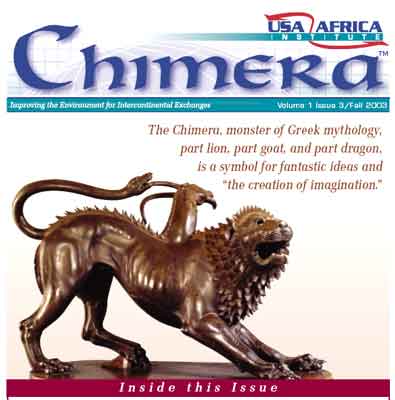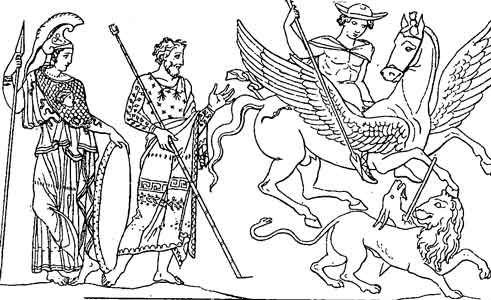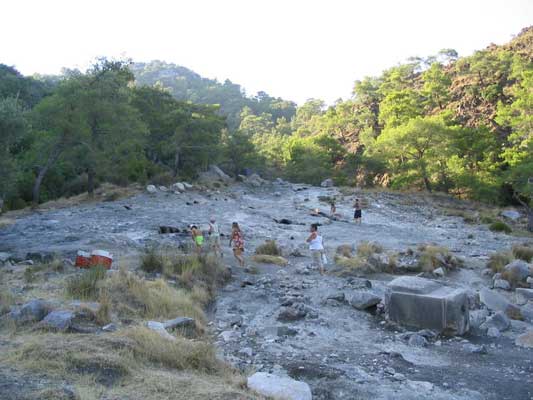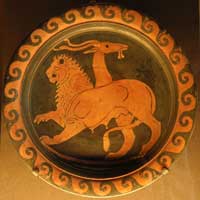.

In Greek Mythology, Chimera (Greek Χίμαιρα [Khimaira]; or Chimaira, Latin, Chimæra) was one of the offspring of Typhon and Echidna.
Descriptions vary – some say she had the body of a goat, the hindquarters of a snake or dragon and the head of a lion, though others say she had heads of both the goat and lion, with a snake for a tail. All descriptions, however, agree that she breathed fire from one or more of her heads.
Her offspring by Orthros were the Sphinx and the Nemean Lion.
Chimera was finally defeated by Bellerophon with the help of Pegasus, the winged horse, at the command of King Iobates of Lycia. There are varying descriptions of her death – some say merely that Bellerophon ran her through on his spear, whereas others say that he fitted his spear point with lead that melted when exposed to Chimera's fiery breath and consequently killed her.
The myths of the Chimera can be found in Apollodorus' Library (book 1), Virgil's Aeneid (book 6), Homer's Iliad (book 6), Ovid's Metamorphoses (book 4) and Hesiod's Theogony.
Sighting the chimera was a sign of storms, shipwrecks, and natural disasters (particularly volcanos). In Medieval Christian art, the chimera appears as a symbol of Satanic forces.
The term "chimera" or "chimeric" is often used metaphorically to describe things that have combined attributes from different sources. In genetics, for example, an organism or tissue created from two or more different genetic sources is called chimeric, as in transplant patients with organs from other donors. See Chimera (animal)
The word Χιμαιρα is Classical Greek for she-goat; billygoat is Χιμαρος .

Athena, Iobates, Bellerophon and the Chimaira
Theory about origin
Chimaera (Geography)

Some say this geothermically active region was the inspiration for the myth. A view of the eternally 'flaming stones' of Yanartas (the ancient Chimaera) near Cinali in southwest Turkey, taken on 8th August 2005. Also visible is a stone from the temple of Hephaistos, some tourists, and the tea-kettle.
Ctesias (as cited by Pliny the Elder and quoted by Photius) identified the Chimaera with an area of permanent gas vents which can still be found today by hikers on the Lycian Way in southwest Turkey. Called in Turkish Yanartaş (flaming rock), it consists of some two dozen vents in the ground, grouped in two patches on the hillside above the Temple of Hephaistos about 3 km north of Çıralı, near ancient Olympos, in Lycia. The vents emit burning methane thought to be of metamorphic origin, which in ancient times sailors could navigate by, and which today is used to brew tea. (Strabo held the Chimaera to be a ravine on a different mountain in Lycia.) [1]
Bellerophon and Pegasos killing the Chimaera Laconian cup, 570 - 565 BC.
MUSIC
Metalcore/Hardcore
- Chimaira - Pass Out Of Existence
| Ancient Greece
Science, Technology , Medicine , Warfare, , Biographies , Life , Cities/Places/Maps , Arts , Literature , Philosophy ,Olympics, Mythology , History , Images Medieval Greece / Byzantine Empire Science, Technology, Arts, , Warfare , Literature, Biographies, Icons, History Modern Greece Cities, Islands, Regions, Fauna/Flora ,Biographies , History , Warfare, Science/Technology, Literature, Music , Arts , Film/Actors , Sport , Fashion --- |
Retrieved from "http://en.wikipedia.org"
All text is available under the terms of the GNU Free Documentation License



